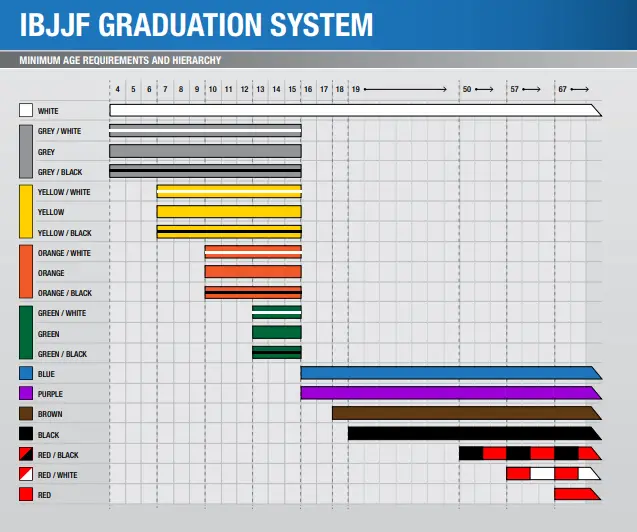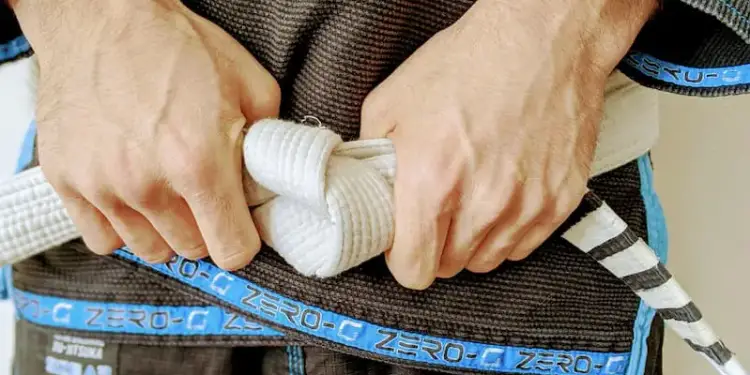The IBJJF belt ranking system is often used as the standard in BJJ academies around the world, with only a few tiny variations in the process in other cases. Even those are relatively rare and the chances are that if you step into your nearest gym, you’ll find them adhering to the IBJJF system. Originally the usage of different coloured belts in Judo and Jiu-Jitsu was done purely to separate instructors from students, but over time the arts began to recognise the benefits of providing a measurable progress record to students. Naturally, giving students goals and progress-markers helps encourage them to stick with the sport and focus on their development in order to reach the next rank. Students are also given singular stripes, up to four, to denote progress within each belt level in the majority of gyms, although not this is not universal.
How Does the IBJJF BJJ Belt Ranking System Work?
There are several belts involved in the IBJJF ranking system, with the white belt being universal among all new starters in the sport. That is always the level at which every person stepping on the mats starts at, regardless of age or any prior experience. While experience in other grappling arts is a pretty safe guarantee of quicker progress through the belt system, the first day on the BJJ mats will always be done as a white belt. From there, the belt system diverges for students depending on age, and the next belt they reach will be different for children and adults. Some belt levels will have time requirements as well, but the IBJJF have introduced rules to allow any competitor who wins an IBJJF world championship at their current rank to ignore any remaining time and be promoted immediately.

How Does the IBJJF Children’s BJJ Belt Ranking System Work?
For children under the age of 16, they have twelve different belts after white belt available to them and none of these can be carried over after that age. There are four primary colours after white belt in the children’s ranking system: grey, yellow, orange, and green. Each of these colours then has three subdivisions within it: the colour with a white stripe running through it, the solid colour, and the colour with a black stripe running through it. The three grey belts are available from the age of 4, the three yellow belts are available from the age of 7, the three orange belts are available from the age of 10, and the final three green belts are available from the age of 13. Some gyms will use the green belt for adults to denote a level of progress between white and blue belt but this is not common, is not recognised by the IBJJF, and is not accounted for in any major competition. There is no minimum requirement of time at any of the children’s belts, so progress rates will vary quite widely between gyms and individual students.
How do You Get to BJJ Blue Belt?
The path to blue belt in BJJ will look different for almost everyone, owing partly to the fact that the IBJJF ranking system doesn’t dictate any minimum time before reaching the rank of blue belt. For many experienced wrestlers and Judoka, they will likely receive a blue belt very quickly thanks to their grappling ability and the fact that the IBJJF will not allow them to compete at white belt anyway. It’s available to students at the age of 16 and for any children reaching that age who already hold any rank above white belt, they must then automatically be promoted to blue belt. For students starting as adults this will likely take somewhere around two years, although that can vary quite a bit depending on how often they train and how quickly they learn.
How do You Get to BJJ Purple Belt?
Purple belt is the only other belt available in the IBJJF ranking system to BJJ students at the age of 16 and 17, and previous green belts are eligible to move immediately to this rank upon turning 16. This is incredibly rare though, with the vast majority being promoted to blue belt. For them to then reach purple belt before they turn 18, there is no minimum time requirement for them to remain a blue belt. Things work slightly differently for adults over the age of 18 though, as they are required to spend a minimum of two years at the rank of blue belt unless they have won an IBJJF world championship at that rank.
How do You Get to BJJ Brown Belt?
Brown belt is only available to those over the age of 18 and it is the first rank in the IBJJF system that has a minimum time requirement regardless of whether students have started as children or adults. All students must spend a minimum of one year at purple belt before being promoted to brown belt, with the only exception being made for those that have won an IBJJF world championship at that level. This is also the final coloured belt rank in the system before black belt too, and after this point athletes are only separated by age and weight in competition instead of experience level.
How do You Get to BJJ Black Belt?
The black belt is often considered to be the holy grail for any martial artist and as far as BJJ competition goes, this is the final rank that really makes any difference. While a tiny number of incredible grapplers have managed to reach this level in just a handful of years, this is usually the culmination of somewhere around a decade or more of hard work on the mats. The minimum age that a student is eligible to reach the rank of BJJ black belt according to the IBJJF system is 19 and they must have spent a year at brown belt prior, again unless they have won an IBJJF world championship at that level.
What Comes After BJJ Black Belt in the IBJJF Ranking System?
Up until the rank of black belt, every belt or stripe given is generally given based on the student’s progress and development in the sport. After this, it’s all based on time served at the rank instead and each stripe (or degree) given indicates a certain amount of time spent as a black belt. The first 3 degrees are given at three-year intervals, and the next 3 are given at five-year intervals. At the rank of 6th degree black belt, it then takes 7 years before the next degree is given and this is the first time that the belt itself changes. This is where the red and black belt is awarded, and it takes another 7 years after this to be given the 8th degree along with the red and white belt.
This means that someone will need to spend a total of 31 years at black belt in order to reach the rank of red and black belt, and a total of 38 years at black belt to reach the rank of red and white belt. After another 10 years, they are given their 9th degree and become one of an incredibly tiny number of solid red belts. The 10th and final degree has been reserved exclusively for the founders of BJJ themselves, Carlos, Oswaldo, George, Gastao, and Helio Gracie. For anyone to reach the final belt rank available in the IBJJF ranking system to the public of 9th degree black belt and receive their red belt, they would need to be at least 67 years old and have dedicated well over 50 years of their life to training and most likely teaching BJJ.
The full list of rules surrounding the IBJJF belt ranking system for BJJ can be found on their official website, here.













